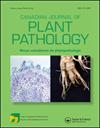加拿大西部小麦赤霉病的最新进展
IF 1.5
4区 农林科学
Q3 PLANT SCIENCES
引用次数: 0
摘要
摘要赤霉病(Fusarium head blight, FHB)是加拿大小麦的一种毁灭性病害,病害监测是病害综合管理、病害预测、优先研究和育种工作、粮食处理和收获后清洁的关键组成部分。我们报告了加拿大小麦中FHB的最新趋势,包括1995年至2021年208,247份样本的数据,包括发病率和严重程度。我们的研究结果显示,自1995年以来,FHB发病率稳步上升,2016年为流行年,随后几年为低发病率年。结果还表明,随着时间的推移,FHB的严重程度一直稳定,但并不总是与发病率相关。2018年至2021年对26538份样本的分析数据表明,镰刀菌受损籽粒数量(严重程度)与真菌毒素脱氧雪腐镰刀菌醇浓度之间存在很强的正相关关系。总之,我们的研究结果提供了迄今为止加拿大最可靠的食品血红蛋白调查,补充了国家和国际疾病监测和管理工作。本文章由计算机程序翻译,如有差异,请以英文原文为准。
A status update on fusarium head blight on Western Canadian wheat
Abstract Fusarium head blight (FHB) is a devastating disease of wheat in Canada and disease surveillance is a critical component of integrated disease management, disease forecasting, prioritizing research and breeding efforts, grain handling, and cleaning post harvest. We report on the recent trends of FHB in Canadian wheat including incidence and severity from 1995 to 2021 based on data from 208,247 samples. Our results show a steady increase in FHB incidence from 1995, with an epidemic year in 2016, followed by several years of low incidence. Results also indicated that FHB severity has been stable over time, but not always correlated with incidence. Data from the analysis of 26,538 samples from 2018 to 2021 demonstrate a strong positive correlation between the number of Fusarium damaged kernels (severity) and concentrations of the mycotoxin deoxynivalenol. Together, our results provide the most robust survey of FHB in Canada to date, which complement national and international disease monitoring and management efforts.
求助全文
通过发布文献求助,成功后即可免费获取论文全文。
去求助
来源期刊
CiteScore
4.50
自引率
5.00%
发文量
56
审稿时长
6-12 weeks
期刊介绍:
Canadian Journal of Plant Pathology is an international journal which publishes the results of scientific research and other information relevant to the discipline of plant pathology as review papers, research articles, notes and disease reports. Papers may be submitted in English or French and are subject to peer review. Research articles and notes include original research that contributes to the science of plant pathology or to the practice of plant pathology, including the diagnosis, estimation, prevention, and control of plant diseases. Notes are generally shorter in length and include more concise research results. Disease reports are brief, previously unpublished accounts of diseases occurring on a new host or geographic region. Review papers include mini-reviews, descriptions of emerging technologies, and full reviews on a topic of interest to readers, including symposium papers. These papers will be highlighted in each issue of the journal and require prior discussion with the Editor-in-Chief prior to submission.

 求助内容:
求助内容: 应助结果提醒方式:
应助结果提醒方式:


